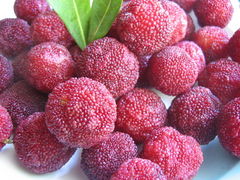Morella rubra
| Myrica rubra subsp. var. | ||||||||||||||||||||||||||||||||||||||||||||||||||||||||
|---|---|---|---|---|---|---|---|---|---|---|---|---|---|---|---|---|---|---|---|---|---|---|---|---|---|---|---|---|---|---|---|---|---|---|---|---|---|---|---|---|---|---|---|---|---|---|---|---|---|---|---|---|---|---|---|---|

|
|
| ||||||||||||||||||||||||||||||||||||||||||||||||||||||
| ||||||||||||||||||||||||||||||||||||||||||||||||||||||||
Myrica rubra, also called yangmei; yamamomo, Chinese Bayberry, Japanese Bayberry, Red Bayberry, or Chinese strawberry tree (and often mistranslated from Chinese as arbutus) is subtropical tree grown for its sweet crimson to dark purple-red fruit.
It is native to eastern Asia, mainly in China.
It is a small to medium-sized tree growing to 10-20 metres in height, evergreen, with smooth gray bark and a uniform spherical to hemispherical crown. It is dioecious, with separate male and female plants. It tolerates poor acidic soils. The root system is shallow (5–60 cm), with no obvious taproot.
The fruit is spherical, 1.5-2.5 cm in diameter, with a knobby surface. The surface color is typically a deep, brilliant red, but may vary from white to purple. The flesh color is similar to surface color, or somewhat lighter. The flesh is sweet and very tart. At the center is a single seed, with a diameter about half that of the whole fruit.
| Standard Cyclopedia of Horticulture |
|---|
|
Myrica rubra, Sieb. & Zucc. (M. Nagi, DC., not Thunb.). Shrub or small tree: branchlets slightly pubescent: lvs. oblong-lanceolate, acutish, cuneate, entire or serrate above the middle, dark green above, paler beneath, glabrous, 3-5 in. long: staminate catkins cylindric; stamens 6-10: fr. globose or ovoid, tuberculate, deep red- purple, ½l in. across; stone ovoid, compressed. April, May; fr. in July. S. China, Japan.—Cult. for its edible fr. There is a variety with rose-colored finer flavored fr. The berries are vinous and sweet with a pleasant acid taste and are used like blackberries; the fresh juice makes an agreeable beverage. The tree is supposed to stand about 15° of frost. Intro, in 1889. The M. Nagi, Thunb., is Podocarpus Nagi.
|
Describe the plant here...
Cultivation
Propagation
Pests and diseases
Varieties
Gallery
-
photo 1
-
photo 2
-
photo 3
References
- Standard Cyclopedia of Horticulture, by L. H. Bailey, MacMillan Co., 1963
External links
- w:Morella rubra. Some of the material on this page may be from Wikipedia, under the Creative Commons license.
- Morella rubra QR Code (Size 50, 100, 200, 500)

